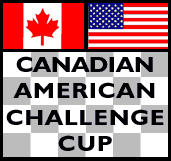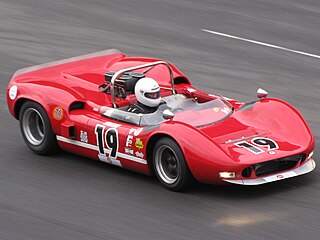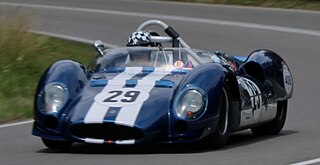
The Ford GT40 is a high-performance endurance racing car commissioned by the Ford Motor Company. It grew out of the "Ford GT" project, an effort to compete in European long-distance sports car races, against Ferrari, which won the prestigious 24 Hours of Le Mans race from 1960 to 1965. Ford succeeded with the GT40, winning the 1966 through 1969 races.
Power-to-weight ratio is a calculation commonly applied to engines and mobile power sources to enable the comparison of one unit or design to another. Power-to-weight ratio is a measurement of actual performance of any engine or power source. It is also used as a measurement of performance of a vehicle as a whole, with the engine's power output being divided by the weight of the vehicle, to give a metric that is independent of the vehicle's size. Power-to-weight is often quoted by manufacturers at the peak value, but the actual value may vary in use and variations will affect performance.

The Canadian-American Challenge Cup, or Can-Am, was an SCCA/CASC sports car racing series from 1966 to 1987.
The Ferrari P was a series of Italian sports prototype racing cars produced by Ferrari during the 1960s and early 1970s.
Chaparral Cars was a pioneering American automobile racing team and race car developer that engineered, built, and raced cars from 1963 through 1970. Founded in 1962 by American Formula One racers Hap Sharp and Jim Hall, it was named after the roadrunner, a fast-running ground cuckoo also known as a chaparral bird.

The Lola T70 is a sports prototype developed by British manufacturer Lola Cars in 1965. Lola built the chassis, which were typically powered by large American V8s.

The McLaren M6A was a Group 7 prototype race car deisnged and developed by driver Bruce McLaren, and built by his Bruce McLaren Motor Racing team for their entry in 1967 Can-Am season. As a replacement for the team's M1Bs from 1966, the Chevrolet-powered M6A's improved design earned Bruce McLaren and his team their first of multiple Can-Am championships. After the M6As were replaced by the M8A in preparation for 1968, McLaren and technical partner Trojan–Tauranac Racing developed the M6B which was sold to customers for use in Can-Am as well as other racing series.

The McLaren M8A was a race car developed by driver Bruce McLaren and his Bruce McLaren Motor Racing team for their entry in 1968 Can-Am season. The M8A and its successors dominated Can-Am racing for four consecutive Can-Am seasons, until the arrival of the Porsche 917.
The Lola T160 is a series of purpose-built Group 7 sports prototype race cars, designed and developed by British chassis manufacturer Lola Cars, specifically to compete in the Can-Am series in 1968. It was the successor to the competitive T70, sharing similar design knowledge and cues. Lola built the chassis, constructed out of fiberglass, and molded into an aluminum monocoque. This meant the car was light was lightweight, weighing only 670 kg (1,480 lb). The chassis was designed to accept a small-block engine, but most cars were powered by either the Chevrolet ZL1 or the Ford FE "big-block" motors, generating about 625–750 hp (466–559 kW); mated to a 4-speed or 5-speed Hewland L.G.500 or L.G.600 manual transmission. This made the cars very fast, with a notably excellent power-to-weight ratio. It was used in active competition until 1971, and was succeeded and used alongside the new T220 in 1970.
The Shadow DN2, also known as the Shadow Mk.III, is a purpose-built sports prototype race car, designed, developed and built built by Shadow Racing Cars to Group 7 racing specifications, to compete in the Can-Am racing series, in 1972 and 1973. It was powered by an extremely powerful Chevrolet big-block engine, developing between 800–1,200 hp (600–890 kW), depending on boost pressure levels, and generating an asphalt-shredding 985 lb⋅ft (1,335 N⋅m) of torque The turbocharged system was used for three races, then the team switched back to a naturally aspirated engine, still producing 735 hp (548 kW); which was more than enough to get the job done.
The Shadow Mk.II, is a purpose-built sports prototype race car, designed, developed and built built by Shadow Racing Cars to Group 7 racing specifications, specifically to compete in the Can-Am racing series, in 1971. It was powered by a naturally aspirated, Chevrolet big-block engine, developing 740 hp (550 kW), and 655 lb⋅ft (888 N⋅m) of torque.
The AVS Shadow, also known as the Shadow Mk.I, is a purpose-built sports prototype race car, designed, developed and built built by Shadow Racing Cars to Group 7 racing specifications, specifically to compete in the Can-Am racing series, in 1970. It was Shadow's first Can-Am car. Powered by a naturally aspirated, Chevrolet big-block engine, developing 740 hp (550 kW), and 655 lb⋅ft (888 N⋅m) of torque.

The BRM P154 is a purpose-built sports prototype race car, designed, developed and built built by British Racing Motors to Group 7 racing specifications, specifically to compete in the Can-Am racing series, in 1970. It was BRM's first Can-Am car. Powered by a naturally aspirated, Chevrolet big-block engine, developing 760 hp (570 kW), and 650 lb⋅ft (880 N⋅m) of torque.

The BRM P167 is a purpose-built sports prototype race car, designed, developed and built built by British Racing Motors to Group 7 racing specifications, specifically to compete in the Can-Am racing series, between 1971. It was BRM's final Can-Am race car chassis. It was powered by a naturally aspirated, Chevrolet big-block engine, developing a solid 600 hp (450 kW).

The March 84G was a mid-engined Group C and IMSA racing sports prototype, designed and developed by March Engineering in late 1983 and used in sports car racing until 1989. It was powered by a number of different engines, including a Chevrolet small-block, a Buick V6, a Porsche flat-six, and even a Mazda 13B Wankel rotary engine. Power output was around 620 hp (460 kW). It only managed to score 5 wins, and clinch a total of 10 podium, over the course of 7 years and 119 race entries.

The McLaren M1A, and its derivatives, the McLaren M1B and the McLaren M1C, are a series of mid-engined Group 7 sports prototype race cars built by McLaren, between 1963 and 1968. The M1A was the team's first self-designed and developed sports car. Later versions, such as the 'M1B' and 'M1C', competed and raced in the North American Can-Am series, starting in 1966 season. The car was raced in North America and Europe in 1963 and 1964 in various Group 7 and United States Road Racing Championship series events. 24 examples of the M1A and M1B were built, and 25 examples of the M1C were manufactured. They were powered by a few different motors, including Chevrolet small-block engine, an Oldsmobile V8 engine, a Chevrolet big-block engine, and even a Ford FE engine. It was constructed out of a tubular space frame chassis, and, combined with its light weight of 551 kg (1,215 lb) this gave it a great power-to-weight ratio. The 4.5 L (270 cu in) Oldsmobile V8 engine developed around 310 hp (230 kW), while the 350 cu in (5.7 L) Chevrolet small-block V8 engine was capable of developing over 550 hp (410 kW), and 538 lb⋅ft (729 N⋅m) of torque. This drove the rear wheels through a Hewland L.G.400 four-speed manual transmission.
The McKee Mk.10, also designated as the McKee Mk.X, is a special purpose-built American sports prototype race car, designed, developed, and built to Group 7 specifications, and competed in the Can-Am series, between 1968 and 1970. It was powered by both an Oldsmobile V8, and a Chevrolet small-block engine.
The McKee Mk.6 is a special purpose-built American sports prototype race car, designed, developed, and built by Bob McKee, in 1966. It competed in both the United States Road Racing Championship, and the Can-Am series. It achieved a total of 2 wins and 5 podium finishes. Career highlights for it include wins at both Road America and Riverside in 1966, a fourth-place finish at Las Vegas in 1966, and another podium finish at Watkins Glen that same year. It was powered by numerous engines, including Chevrolet, Ford, and Oldsmobile motors.
The McKee Mk.14, is a special purpose-built American sports prototype race car, designed, developed and built by Bob McKee, and built to Group 7 specifications, for the Can-Am series, in 1969. It was experimental, but ultimately unsuccessful, failing to start the only race it entered; the 1969 Road America Can-Am round.

The Cooper T61 , also known as the Cooper T61 Monaco, or the Cooper Monaco T61, is a sports racing car, designed, developed and built by British manufacturer Cooper, in 1961. It is the successor and evolution of the T57. Its motor racing career spanned 6 years ; where it won a total of 16 races, achieved 23 podium finishes, and clinched 3 pole positions. It was powered by a number of different engines, including a Coventry Climax four-cylinder engine, a Maserati V8 engine, a Ford FE engine, and a Chevrolet small-block engine.









